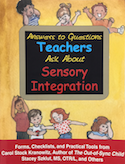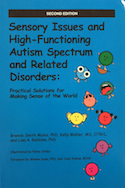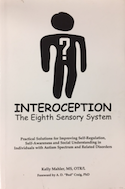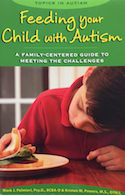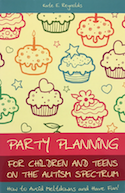2018-2019 Archive
Visual Considerations for the Classroom
September
Students with autism spectrum disorder may have difficulty organizing visual sensory input within the classroom. Overhead fluorescent lights can be a source of sensitivity to them. Consider using more natural light or incandescent lighting, or cover fluorescent lights with light filters. Limit the amount of items hanging from the ceiling, on the walls or exposed on shelves. Create a clear, clutter-free classroom. Too much visual stimulation may distract a student from learning or engaging in productive work.
For examples of sensory interventions including visual supports, visit the OCALI lending library Sensory Kit: Middle School-High School
Proprioceptive Considerations for the Classroom
October
Many students with ASD have difficulty interpreting sensations through their muscles, joints, ligaments and tendons. Some students may need activities built into their school day routine to calm and regulate them while others may need activities to wake up their muscles, informing them to get ready to learn. Proprioceptive input can help regulate emotional and behavioral responses to sensory stimulation. As always, talk with the school occupational therapist to identify proprioceptive activities as well as when, how often, and where the activities should occur.
For examples of proprioceptive supports, visit the OCALI lending library Sensory Kit: Preschool-Early Elementary
Vestibular Considerations for the Classroom
November
Some students with autism spectrum disorder have challenges knowing where their body is in space, if their body is still or moving, and in what direction their body is going. As the weather changes and outside recess moves inside, students may need more time to move. Adding movement breaks to the class routine can benefit all students, and definitely those with vestibular concerns. Assigning a student job, such as taking a note to another teacher or getting the mail, adds some movement to their day. Check with your occupational therapist for additional activities.
To learn more about sensory differences and specific strategies, visit the OCALI lending library resources such as Answers to Questions Teachers Ask About Sensory Integration by Koomar, Kranowitz, Szkut, et al.
Sensory during the Holidays
December
The sights, sounds and smells of the holidays can be overwhelming for students with ASD. Classroom parties, additional decorations, crafts, choir and band concerts and changes in routine can contribute to stress and anxiety. Prime students of changes, consider more sensory breaks, write social narratives related to the holiday events and remember to consider the child's sensory needs in all activities.
To learn more information about sensory differences and specific strategies visit the OCALI lending library resources such as Sensory Issues and High-Functioning Autism Spectrum and Related Disorders by Myles, Mahler and Robbins.
Auditory Considerations for the Classroom
January
Some students with autism spectrum disorder may have sensitivities to certain sounds. Some may respond negatively to loud noises such as fire alarms or loud speaker announcements or may be irritated by the smallest of noises like a class fan while others appear to not hear certain sounds at all. Visual cues can be used as alternatives to assist students with understanding the various noises that occur within a classroom. Consult an occupational therapist to identify specific interventions such as noise reducing headphones and other environmental supports to address auditory needs.
For examples of auditory supports, visit the OCALI lending library Sensory Kit
Interoceptive Considerations for the Classroom
February
Interoception allows individuals to experience feelings of hunger, pain, illness, the need to use the restroom, and emotions such as sadness, anxiety, fear, etc. When the interoceptive system is compromised, students may not be able to regulate their emotions and express their needs appropriately. Providing students with language and communication strategies, calming or alerting activities, mindfulness activities and social emotional learning activities may support interoceptive functioning in the classroom.
To learn more about the Interceptive System, visit resources in the OCALI lending library, such as Kelly Mahler's book Interoception: The Eighth Sensory System.
Tactile Considerations for the Classroom
March
Many students with autism spectrum disorder have strong dislikes to particular tactile sensations. Art supplies such as finger paint, sand, glue, and clay may be aversive to certain students. Particular types of clothing may be disliked by some students. Additionally, some students are easily upset by someone standing too close to them in line or from being touched, while others may stand or sit too close to others and touch things and people to explore the environment. If you notice any of these tactile differences or others, consult with an occupational therapist to identify strategies.
To learn more about the various sensory systems, explore the Autism Internet Module (AIM): Sensory Differences
Olfactory/Gustatory Considerations for the Classroom
April
The sense of smell and sense of taste may also be problem areas for students with ASD. Certain smells and specific tastes or textures can be challenging. Pungent or fragrant odors in the classroom should be avoided. Offer a broad variety and allow choices of food at snack time, lunch and other times during the school day when food is available.
To learn more information related to olfactory/gustatory differences, visit the OCALI lending library Books: Feeding Your Child with Autism by Mark Palmieri; Just Take a Bite: Easy, Effective Answers to Food Aversions and Eating Challenges by Lori Ernsperger.
Sensory Considerations for the End of the School Year
May
As the end of the school year approaches, you may notice your students becoming more anxious and needing more sensory supports. It is not uncommon for anxiety to increase at the end of the school year with the changes in schedule and routine and saying goodbye to friends and teachers as well as the end of the year cumulative assignments and papers, exams, field day, school assemblies, graduation, parties, etc. Prime students in advance for the changes that will be occurring. Increase opportunities to engage in sensory activities.
For more information on how to support students with ASD during celebratory occasions, visit the OCALI lending library resources such as Party Planning for Children and Teens on the Autism Spectrum: How to Avoid Meltdowns and Have Fun! By Kate Reynolds.
